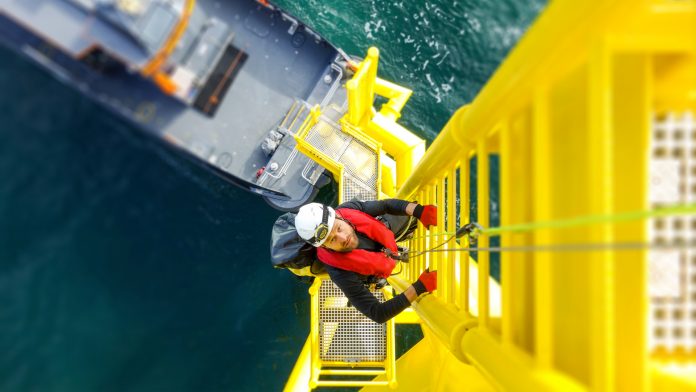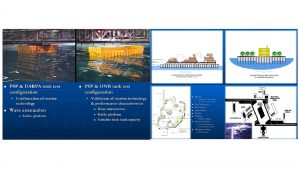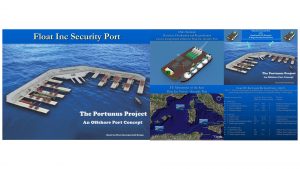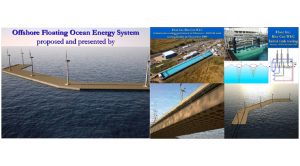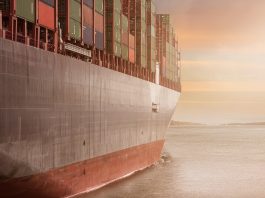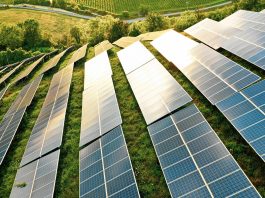Franklin Martin, Managing Director of Float Europe, presents the benefits of using large floating platforms in the drive toward renewable energy goals and reduced CO2 emissions.
The legally binding international treaty on climate change, the Paris Agreement, seeks to limit global warming to below 2°C. Reducing our global greenhouse gas emissions is at the heart of this aim and has captured the imagination of many in the energy sector – innovative floating platforms may provide the answer.
How can great minds and technology come together to save our planet? What are the problems that require a response? In terms of energy production, they are:
- Reduction of CO2 pollution;
- Capture/conversion of renewable energy sources; and
- Expansion of existing systems – subject to population or industry growth.
The types of renewable energy that are currently available for capture and conversion into grid electricity are:
- Wind (SeaWind);
- Wave (OFOES); and
- Ocean currents (hydro-turbines).
And the additional aspects to obtain reduced CO2 pollution include:
- Application of systems that enable grid electricity to be obtained locally;
- Reduction of container vessel voyages; and
- Reduction of trans-shipment of containers over great distances.
How may this be accomplished in the most compact and feasible manner? By using a floating platform for the generation of clean electricity out at sea. The benefits of floating platforms include:
- Being free to move if market conditions change;
- It may be built remotely from the operating site and connected to pre-installed moorings, pipes, and power lines;
- Platforms require less construction material than a GBS;
- They are easily disposed of when its long and useful life has ended; and
An OFOES platform has small motions which are compatible with docked vessels, this reduces TEU movements between ULCC and Short Sea Shipping Vessels and so results in the reduction of further modifications to ashore ports and thus EU expenditures for upgrades to support further TEU growth.
Additionally, they would no longer require ashore ports to expend funds to enable the ULCC vessels to berth and off/on load TEU’s in ashore port(s).
Floating platforms can be used to host a wide range of power generation like wind, wave, and ocean currents, but also LNG and hydrogen storage. For instance, Waller Marine Inc offers new and alternative power generation using floating platforms around the world. Perhaps the most notable is the world’s largest floating power generation facility applying large capacity GE 7FA industrial gas turbines in Venezuela.
The benefits of floating platforms are not just limited to power generation – they can also be used for port security in an increasingly uncertain world.
The challenges facing Europe’s ports
Europe’s ports are crucial for transport business and have a huge potential for job creation and investment. They are the gateway to the European continent with 74% of extra EU goods shipped through ports alone. But they face major challenges:
- Predicted growth of 50% in cargo handling by 2030, and 80% by 2050;
- A structural performance gap in Europe’s port efficiency – of the 329 existing ports, 83 require upgrades – adding a predicted cost of 1.5 trillion Euros by 2030; and
- The changing nature of shipping means EU ports must adapt to the changing needs of the industry.
o EU Member States could reinstate short sea shipping (SSS) and seafarers for each of their port facilities as EU populations are predicted to increase to 739 million by 2030.
Containers could be delivered directly to a strategically positioned offshore deep sea shipping platform, i.e. Float Incorporated Security Port, that would provide a direct service to each EU Member State via SSS vessels. This results in a positive impact in that all Member States can avoid EU crossroad transshipment, thus reducing road traffic and CO2 emissions, decreasing delivery times and costs to each client.
It is estimated that more than 1,100 SSS vessels are currently idle. They could be re-activated and manned by seafarers (10 seafarers per SSS vessel) to directly transship containers to their EU Member State destination.
The ultra large container ships (ULCS) could reduce their voyage times by four to six days resulting in reduction of ULCS operations costs. Additionally, the reduction of CO2 emissions via road transshipment and potential pollution of the English Channel are enhanced by the positioning of the Float Inc. Security Port offshore, as an example – from Mizen Head, Ireland.
Offshore Security Ports
Once fully certified and operational, Europe’s first offshore hub for floating platforms could be operational within the ‘Atlantic Arc’ and Mediterranean Sea zones, with an electricity baseload powered by renewable energy, and configured as an automated container handling port hub. This hub, capable of automated reception, weighing, and 100% inspection of all inbound and outbound TEU’s would thereby increase the EU security profile; expediting the inbound TEUs to their country core port and comprehensive networks of European ports and logistic centers via the core network corridors to their member state port destination using SSS container vessels.
Future US ports could be located in the ocean, 20-40 miles from shore, under the proposed Portunus project. The offshore port concept would allow cargo to be inspected far away from cities as one way to increase homeland security.
Our concept for this system of offshore security (adopted by the Lawrence Livermore National Laboratory) is the leading means to frustrate any terrorist attack on the CONUS via maritime traffic. The offshore port concept would allow cargo to be inspected far away from cities as one way to increase homeland security.
Offshore Floating Energy System (OFOES) composition
The Float Incorporated Security Port is composed of the Pneumatically Stabilized Platform (PSP) and Rho-Cee Wave Energy Converter that incorporates Potential Energy Storage (PES) capabilities, all within the same floating energy platform system. The system and the PSP are a patented design and constructed to enable the stable Offshore Floating Ocean Energy System (OFOES) to remain afloat under heavy sea states, as well as pre-calculated deck loads. OFOES and PSP are also constructed of post constraint, reinforced concrete and built to last 70+ years.
The PSP consists of:
- A monolithic platform;
- A stable with variable deck loads capabilities;
- It is modular, mobile, and extensible;
- Wave attenuation results in calm water zone leeward;
- It is environmentally-friendly; and
- It has a long life with minimal hull maintenance and no out-of-service time.
Wind farms at sea
Furthermore, the SEAWIND two-blade wind turbines are mounted on the forward (leading) edge of the OFOES and provide additional grid quality electricity which is complementary to the Rho-Cee WEC for renewable energy production. The PES (Potential Energy Storage) is obtained by utilising pre-determined PSP cylinder dimensions that are designed to receive and store electricity in the form of compressed air, resulting in a storage of compressed air that can be recuperated, heated, and transformed into grid quality electricity.
The SEAWIND two-blade wind turbines, inspired by helicopter technology, have a 25% lighter nacelle weight compared to three-blade technologies, and are towed out to sea for installation, without requiring cranes or heavy vessels, thus helping reduce a CO2 emissions.
The 12MW turbine solution is highly cost effective for large wind farms, handling wind speeds 3.5m/sec to 25m/sec.
The Rho-Cee WEC system
The Rho-Cee WEC system is designed as the means to capture and convert wave energy into electricity using the Trident Energy power take-off units, therefore providing grid quality electricity to the PSP/OFOES/ Security Port. The combination of the Rho-Cee WEC and PSP provides dampened sea states to the leeward side of the platform for improved ship docking.
Trident Energy’s patented direct drive linear generator allows linear motion to convert directly into electricity without traditional gear boxes or hydraulics. It is a simple and reliable method with cost advantages for a variety of offshore energy applications, providing clean, sustainable electricity.
Underwater marine turbine installations can be designed and determined based upon site specifics, allowing for a range of platforms suitable for each project.
On-the Job Training (OJT) of candidate personnel is also possible by means of a small-scale OFOES which could be installed in most any bay and provides OJT for interested parties for eventual employment on-board an active OFOES.
Employments onboard can be determined by OFOES applications, providing manning requirements and candidate site specifics.
One incredible benefit of an OFOES on the environment (and when a system is eventually decommissioned) is that it does not affect marine life as they will propagate within the sunken OFOES platform units which could be distributed where needed.
Application combinations/configurations possible onboard the OFOES:
- Wave energy via the Rho-Cee WEC;
- Wind energy via Seawind wind turbines;
- Hydrogen generation and storage;
- Aquaculture – controlled and contained + processing;
- Seaweed – raised/controlled/harvested onboard OFOES;
- OFOES Security port configuration;
- Seawind two-blade wind turbines 12.2MW;
- LNG/Hydrogen generation & storage; and
- EAWC Technologies – trash combustion and saleable waste materials.
- Floating real estate – buildings up to 10 stories high;
- Marinas;
- Breakwaters;
- Helicopter landing and parking floating facility;
- Yacht berthing; and
- Floating parking facility (cars and trucks).
Offshore Floating Ocean Energy Platform configurations
The opportunities to use floating platforms for a wide range of uses are almost endless.
- Airports – Our FloatPort was first introduced in 1993 and provides a complete international airport, and a terminal for commuter and maritime traffic. The Pneumatically Stabilized Platform was originally designed as a means for constructing a new airport for San Diego in the Pacific Ocean, three miles off the tip of Point Loma. This would make San Diego the only deep water shipping port on the West coast and provide the world with its first land, air, and sea inter modal transport center. Connected by a tunnel to the Western terminus of Interstate 8, one of the city’s main collector freeways, FloatPort would be as convenient as San Diego’s Lindbergh Field is now;
- Aquaculture – When based on the tank testing of the PSP as well as that of the Rho-Cee WEC system, the ‘additional’ means to contain and control aquaculture (hatchery to preparations to market), are sequences already in use around the world today. Combining all the same offshore/nearshore OFOES respond to numerous demands, e.g. providing a stable platform, and being expanded without any interruption to existing systems. An OFOES may be towed to a desirable zone to provide marine life with a ‘compatible’ home by sinking the system to the ocean floor;
- Ports and harbours – especially useful in our Float Incorporated Security Port;
- Wind Turbine Farms and Ocean-Current Arrays – as per those used at Ireland’s Rockwall Trough;
- Breakwaters – essential within LNG liquefaction and re-gasification facilities;
- Islands for marinas and resorts – a beautiful concept that can transform the leisure and tourism sector; and
- Expansion of coastal and urban areas – particularly useful for airport development and floating real estate.
Franklin Martin, representing Float Incorporated in Europe, has previously proposed the following prospective projects:
- Seaborne urban expansion of the Principality of Monaco;
- Floating parking, warehousing, and heliport structures for the Principality of Monaco;
- Floating heliport for Ramatuélle and Saint Tropez, France;
- Desalinisation facilities for Cypress and Slovenia;
- Cruise ship terminals for Nice and Cannes, France, and Koper, Slovenia;
- Floating breakwaters/marina to limit beach erosion for Antibes and Nice, France;
- Aviation fuel terminal for Nice Côte d’Azur Airport;
- Combined-source ocean energy system for the European Union;
- West-Med corridor motorways of the seas for the European Union; and
- Adriatic Island project for Slovenia.
We are committed, and excited, to continue our emphasis on transforming how we harness Nature’s power and beauty through the use of our floating platform systems, and we look forward to contributing to the efforts to reduce CO2 emissions.
Please note, this article will also appear in the sixth edition of our quarterly publication.

